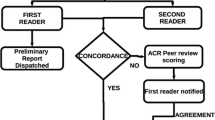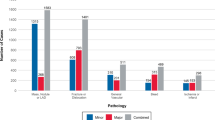Abstract
Rationale and objective
Variation of visual selective attention through the day has been demonstrated in several arenas of human performance, including radiology. It is uncertain whether this variation translates to an identifiable diurnal pattern of error rates for radiology interpretation. The purpose of this study was to attempt to identify particular days of the week and times of the day when radiologists might be most prone to error.
Materials and methods
Abdomen/pelvis CT studies containing at least one major error were collected from a 10-year period from the quality assurance (QA) database at our institution. A major error was defined as a missed finding that had altered management in a way potentially detrimental to the patient. The identified studies were categorized by the day of the week and hour of the day that the study was interpreted. Study volume data over this same period was also obtained by day of the week and time of day, so to normalize the data based on case volume. Standard errors of the volume-adjusted error rates were obtained based on the binomial distribution. The null hypothesis of constant error rates over time was tested using a weighted logistic regression model with linear time as predictor.
Results
A total of 252 major errors were identified. More errors were made on Monday than on any other day of the week (n = 58). Major error rates increased through the mid to late morning (9 am to 12 pm), and then decreased progressively through the afternoon until 4 pm, when a rise in the error rate was seen. This pattern persisted when error rates were normalized by study volume within each hour. Overall tests of time-constancy of error rates by day and hour were statistically significant (both p-values < 0.001).
Conclusion
Our study shows that error rates in abdominal CT do seem to vary with time of day and day of the week. During the workweek, error rates were highest in the late morning and at the close of the workday, and greater on Mondays than other days.




Similar content being viewed by others
References
Rutenfranz J, Colquhoun WP. Circadian rhythms in human performance. Scand J Work Environ Health 1979. 5:167e77
Colquhoun WP. Circadian variations in mental efficiency. W.P. Colquhoun (Ed.), Biological rhythms and human performance, Academic Press, London (1971), pp. 39–107
Gale AG, Murray D, Millar K, Worthington BS: Circadian variation in radiology. In: Gale AG, Johnson F Eds. Theoretical and applied aspects of eye movement research. Elsevier, London, 1984.
Taylor-Phillips S, Clarke A, Wallis M, et.al. The time course of cancer detection performance. Proc SPIE Med Imag 2011 7966:796605–1–8.
Al-s’adi M, McEntee MF, Ryan E. Time of day does not affect radiologists’ accuracy in breast lesion detection. Proc SPIE Med Imag 2011. 7966:796608–1–7.
Alshabibi AS, Suleiman ME, Tapia KA, Brennan PC. Effects of time of day on radiological interpretation. Clin Radiol. 2020. 75(2):148–155.
Goldberg-Stein S, Frigini LA, Long S, et al. ACR RADPEER Committee White Paper with 2016 Updates: Revised Scoring System, New Classifications, Self-Review, and Subspecialized Reports. J Am Coll Radiol 2017. 14(8):1080-1086.
Hallas P, Ellingsen T. Errors in fracture diagnoses in the emergency department--characteristics of patients and diurnal variation. BMC Emerg Med. 2006;6:4. Published 2006 Feb 16.
Brogdon BG, Kelsey CA, Moseley RD: Effect of fatigue and alcohol on observer perception. Am J Roentgenol 1978. 130:971–974.
Buckley, D., Reyment, J. and Curtis, P. "The witching time: diurnal patterns in adverse events of clinical management", Clinical Governance: An International Journal 2009. Vol. 14 No. 4, pp. 281-288
Krupinski, EA, Reiner, BI. Real-Time Occupational Stress and Fatigue Measurement in Medical Imaging Practice. J Digit Imaging 2012. 25, 319–324
Krupinski EA, Berbaum KS, Caldwell RT, et al. Long radiology workdays reduce detection and accommodation accuracy. J Am Coll Radiol 2010, pp. 698–704,
Stec N, Arje D, Moody AR, et al. A systematic review of fatigue in radiology: is it a problem? AJR 2018, 210, pp. 799-806,
Krupinski EA: Reader fatigue interpreting mammograms. .Lect Notes Comput Sci 2010. 6136:312–318.
Waite S, Grigorian A, Alexander RG, et.al. (2019) Analysis of Perceptual Expertise in Radiology – Current Knowledge and a New Perspective. Front Hum Neurosci 2019. 13:213.
Reicher MA, Wolfe JM. . Let’s Use Cognitive Science to Create Collaborative Workstations. Journal of the American College of Radiology 2016. 13(5):571-575.
Waite S, Farooq Z, Grigorian A, et. al. A Review of Perceptual Expertise in Radiology-How it develops, How we can test it, and Why humans still matter in the era of Artificial Intelligence. Academic Radiology 2020. 27 (1), pp. 26-38.
Tajmir SH, Alkasab TK. Toward Augmented Radiologists: Changes in Radiology Education in the Era of Machine Learning and Artificial Intelligence. Acad Radiol 2018. 25 (6), pp. 747-750.
Author information
Authors and Affiliations
Corresponding author
Additional information
Publisher's Note
Springer Nature remains neutral with regard to jurisdictional claims in published maps and institutional affiliations.
Rights and permissions
About this article
Cite this article
Kliewer, M.A., Mao, L., Brinkman, M.R. et al. Diurnal variation of major error rates in the interpretation of abdominal/pelvic CT studies. Abdom Radiol 46, 1746–1751 (2021). https://doi.org/10.1007/s00261-020-02807-w
Received:
Revised:
Accepted:
Published:
Issue Date:
DOI: https://doi.org/10.1007/s00261-020-02807-w




